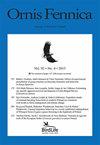利用温度数据记录仪评估孔洞筑巢雀鸟羽化的时间
IF 1.2
4区 生物学
Q2 ORNITHOLOGY
引用次数: 0
摘要
在晚育鸟类中,孵蛋期的长度,即从孵化到羽化(雏鸟离巢)的时间,在不同物种内和不同物种之间是不同的。然而,一般来说,羽翼发育时间的变化和介导这种变化的因素在很大程度上仍未被探索。为了评估雏鸟离巢的时间,每天的观察员通常在预测的羽化期对巢进行访问。然而,这可能会导致幼鸟过早羽化和/或增加被捕食的风险。硬币大小的温度数据记录仪iButtons的应用,越来越多地用于鸟类学研究,可能有助于克服这些障碍。我们测试了iButtons记录的巢温是否可以用来识别幼鸟羽化的日期和时间,即在一种小洞巢雀鸟-大山雀(Parus major)中,最后一个雏鸟离开巢的时间。我们在38个雏鸟14-15日龄(孵化日=第0天)的巢中安装了iButtons,并在雏鸟孵化后第17天或更晚开始的日常检查中验证了雏鸟的存在。我们发现,雏鸟羽化的日期可以根据巢杯温度和外界温度的差异来准确确定。雏鸟的羽化年龄在17 ~ 22天之间,其中近58%的雏鸟在20 ~ 21天羽化。多数(81.6%)雏鸟在日出后6小时内羽化。我们讨论了使用iButtons来识别晚熟鸟类羽化时间的优点和缺点。本文章由计算机程序翻译,如有差异,请以英文原文为准。
Assessing timing of fledging in a cavity-nesting passerine using temperature data loggers
In altricial birds, the length of the nestling period, i.e. time from hatching until fledging (young leaving the nest) varies within and between species. In general, however, variation in the time of fledging and factors mediating such variation remain largely unexplored. To assess the time of nestlings leaving the nest, daily observer visits to the nest are usually done in the predicted fledging period. However, this might initiate premature fledging of young and/or increase the predation risk. The application of iButtons – coin-sized temperature data loggers, which are increasingly used in ornithological studies – may help to overcome these obstacles. We tested whether nest temperatures recorded with iButtons might be used to identify the date and hour of young fledging, i.e. when the last nestling in the brood left the nest, in a small cavity-nesting passerine – the Great Tit (Parus major). We installed iButtons in 38 nests when nestlings were 14–15 days old (hatching day = day 0) and verified the presence of nestlings during daily inspections starting on day 17 post-hatching or later. We found that the day of fledging could be accurately determined based on the difference between the temperature of the nest cup and the outside. The age of nestlings ranged between 17 and 22 days at fledging, with nearly 58% of broods fledging at the age of 20 and 21 days. The majority (81.6%) of broods fledged within 6 h after sunrise. We discuss the advantages and disadvantages of using iButtons to identify fledging time in altricial birds.
求助全文
通过发布文献求助,成功后即可免费获取论文全文。
去求助
来源期刊

Ornis Fennica
生物-鸟类学
CiteScore
2.00
自引率
0.00%
发文量
14
审稿时长
>12 weeks
期刊介绍:
Ornis Fennica is a peer-reviewed international ornithological journal published by BirdLife Finland. Ornis Fennica publishes analytical and experimental papers on the ecology, behaviour and biogeography of birds. Ornis Fennica prefers studies concerning Fennoscandian species, but other novel contributions of general interest are most welcome as well.
Ornis Fennica is an open-access journal without page charges for publication. All published articles (from 1924 onwards) are freely available from the journal website. First decisions are usually made within three months of submission.
 求助内容:
求助内容: 应助结果提醒方式:
应助结果提醒方式:


